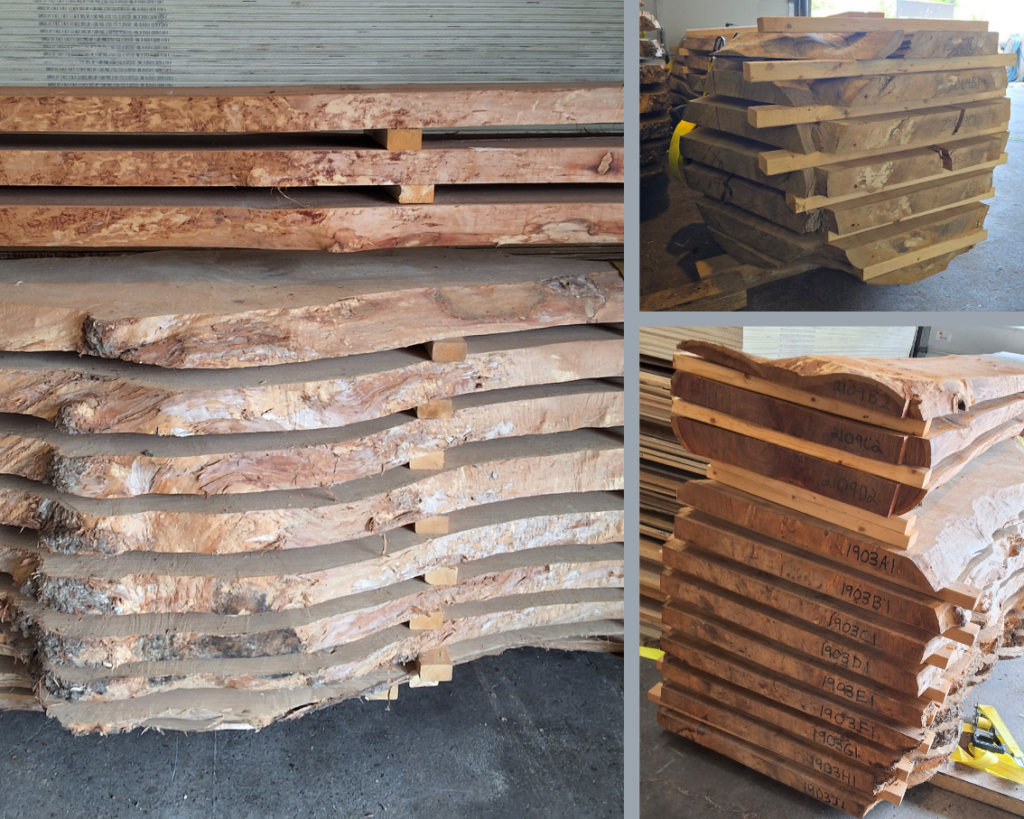Boules, and Wood Flooring

A “boule” (I thought you’d never ask!) is a whole butt – or base – log that has been sawn into boards or slabs, and stacked sequentially in the sequence they were cut. A few mills will sell them like this, rather than sawing the logs in whatever way produces the most lumber. “Who cares?” one might ask. “What difference does it make?” Well, getting the lumber from the same log enables the user to perfectly control grain and color. As you all know, there can be obvious variations in those characteristics, from one log to another, within the same species of wood. These become evident when you are gluing up boards/slabs to create a wide table or bar top. They also can be very obvious when boards are end matched, such as in flooring. With cheaper grades of flooring, sometimes the grain and color of different pieces can be so far apart that it looks downright ugly.
Many a customer has asked me why the “select” grade of wood flooring is so much more expensive than the “clear” grade. Aren’t they both clear? Yes, they are both clear; but that is where the similarity ends. The “clear” grade includes many more short pieces, some little longer than a foot, or shorter. While shorts may be suitable for warehouse or shop floors, as they were extensively used in the old mill buildings, I think they look awful in a residence. The “select” grade contains mostly longer lengths. Good floor layers will use shorts as the starting and ending pieces of a run, with the long lengths in the middle of the floor, and save shorts for use in closets.
Barney & Carey supplied all new select white oak flooring for a Newton Victorian that was being restored. When I delivered it, I saw a large pile of the flooring that they had removed. They were replacing it because wide gaps had appeared between the boards over the 100 plus years of their service. It was rift and quarter sawn (which avoids the often wild grain of flat sawn) White Oak, in lengths of up to fourteen feet. The demo guys somehow had avoided breaking off the tongues and grooves as they tore it up. When I asked, the customer said she was putting it in the dumpster. She was happy to give it to me, and it has now become the floor in my home office. I couldn’t understand why she didn’t reuse this beautiful old flooring, by removing it and then re-laying it snugly.
We supply a lot of custom moldings, cabinetry, and flooring to people who are restoring Victorians and other older homes. Some are surprised to see that 100+ year old exterior trim can still be intact. These moldings were often made of Cypress, which can withstand rot at least as long as pressure treated lumber, unlike the finger jointed pine‑made up of lots of very small pieces-so prevalent today. I would prefer solid primed pine with sound, tight knots, any day over clear finger jointed! Whenever possible, we prefer to have flooring custom milled for our clients’ projects. It is no more expensive than bundles of commercially produced flooring, especially when wider widths are sought, and the buyer can specify exactly what they want. And yes, we can supply your moldings in Cypress.
Getting back to boules, we just bought A LOT of them, sawn to many sizes, and including unusual species. We are currently trying to organize space for it, and we have even more coming in! I will describe them in detail in my next blog. We want to have the best selection possible, and we may already have the largest inventory of slabs and boules in Eastern Mass. Window shoppers welcome! (It’s like puppies; when you go to look at them, you WILL buy one!)
